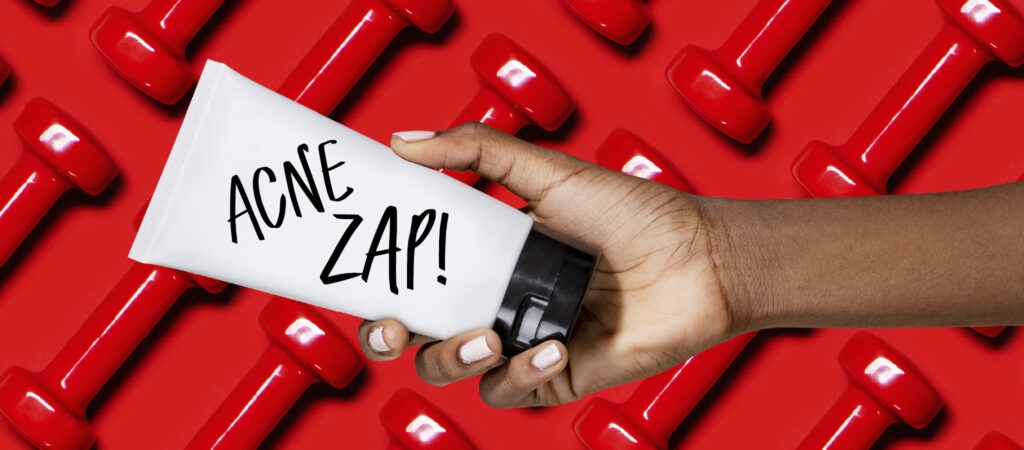6 Tips for Preventing Post-Workout Acne

Medically reviewed by Dr. Nancy Shannon, MD, PhD on April 15, 2021
It’s an all-too-familiar cycle for most: go to the gym and notice acne breakouts in the days following. Sweat and friction of a workout can cause breakouts, although regular exercise coupled with an effective acne treatment plan can actually help reduce acne in the long term.
How sweat causes acne
While sweat can actually help remove bacteria and other debris from your pores, if you don’t take action to remove the sweat from your body those contaminants will stay on your skin. Dried sweat, in combination with makeup and dirt, can clog pores and cause inflammation that results in acne.
How friction causes acne
Certain areas, like the buttocks or back (often under the area covered by [sports] bra) can be more susceptible to break-outs due to rubbing/chafing of the skin, heat and sweat that can cause inflammation of the hair follicles.
Nurx offers prescription treatment for acne, anti aging, melasma, rosacea, and eyelash growth.
The good news is that breakouts like these can usually be avoided — if you take the proper steps to do so. Here’s what you need to know if you’re looking to reduce post-workout acne:
Tip: Remove makeup ahead of time.
While makeup by itself generally doesn’t cause acne, especially when labeled “non-comedogenic,” when it mixes with sweat make-up can make the skin more prone to acne (even more so for products that are not labeled “non-comedogenic”). Thick foundations or anything that comes in a solid compact should be avoided because they tend to block sweat and sebum from leaving the skin, which can lead to blackheads and acne. Remove make-up preferably with a gentle cleanser and water, but in a pinch make-up removal wipes can do the trick. If you don’t feel comfortable going makeup-free, opt for water-based foundation or mineral formulations.
Tip: Protect your skin ahead of time.
An ounce of prevention is worth a pound of cure when it comes to acne. While it may be hard to stop exercise-related sweat, you can make sure your skin is as healthy and hydrated as possible ahead of time. Moisturizing before and after a workout (with a non-comedogenic topical) can help prevent skin irritation related to body temperature, drying sweat, or dry air. If your workout is taking place outdoors, make sure to apply a layer of sunscreen (SPF30+) beforehand and consider wearing sun protective clothing. Too much direct sunlight harms the skin and incurs the risk of both acne and sun damage.
Tip: Wear breathable loose-fitting clothes.
Gym outfits may generally be a form-fitting affair, but those concerned about post-workout body acne should think twice before going skin-tight. Wearing athletic clothes that are too constricting prevents sweat from escaping from the body naturally, causing clogged pores and acne. The excessive rubbing caused by form-fitting clothes can also irritate the skin which makes acne breakouts more likely. Breathable, loose-fitting clothing helps prevent that from happening.
Regardless of what clothes you wear during exercise, take them off as soon after your work-out as possible. The dried sweat and dirt that collects in athletic wear can rub back into your pores if you keep your clothing on too long, increasing the chances of post-workout pimples.
Tip: Clean equipment before use.
Especially in the age of COVID-19, equipment cleaning should be common practice: shared gym equipment is a hot spot where bacteria can grow and thrive. That same bacteria can also find its way into and around your pores, causing acne breakouts, especially if you use the equipment and then touch your face or wipe sweat off your forehead. If you go to the gym, regular equipment wipedowns are an obvious must: before you use any machine or lift any weight, clean it off first using a disinfectant with at least 70% alcohol. Err on the side of caution and make sure to wipe down handles, padding, weights, and any other high-touch spots. If you use exercise equipment within your home, give each machine a complete wipedown before and after your workout and consider adding a deep-clean once a week.
Tip: Avoiding touching parts of your body prone to acne.
Lots of workouts are hands-on in nature, requiring you to lift weights, adjust machines, move equipment, and so on. This means that the primary points of contact between your body and bacteria-covered surfaces during your workout are your hands.
Washing your hands or using hand sanitizer before, during, and after your workout is key for keeping them as clean as possible, but acne prevention requires that you take a step further and avoid touching any part of your body prone to acne breakouts. Most important here is the face, which is highly sensitive to the kinds of dirt, sweat, and bacteria that could be found on your hands while exercising.
Tip: Wash your body — however you can.
A proper workout could cover your skin in dirt, sweat, and other acne-causing substances. This is natural and unavoidable: sweating during a hard workout is nothing to worry about. As soon as your workout is finished, though, take care to wash your skin thoroughly. Dirt and dried sweat often builds up and clogs pores, the primary cause of post-workout acne.
While a shower is the optimal way to wash after exercise, there are other ways for those who don’t have the time. A full-body wipe down with a cleansing cloth can do the trick in a pinch, as can carefully rinsing off parts of your body where sweat collects. The more thorough you can be, the better, but remember that your skin is likely going to be a bit sensitive after you work out, so don’t irritate it any further by washing too vigorously. For the same reason, be sure to use mild, oil-free cleansers during your post-workout wash.
If your post-workout acne is sticking around for longer than you’d like it to, it might be time to look for long-term solutions. Our medical advisors at Nurx can help you figure out exactly what treatments might work for you — just get in contact with a member of our team to see what your next steps should be.
This blog provides information about telemedicine, health and related subjects. The blog content and any linked materials herein are not intended to be, and should not be construed as a substitute for, medical or healthcare advice, diagnosis or treatment. Any reader or person with a medical concern should consult with an appropriately-licensed physician or other healthcare provider. This blog is provided purely for informational purposes. The views expressed herein are not sponsored by and do not represent the opinions of Nurx™.







